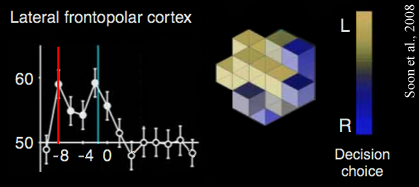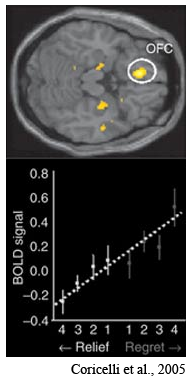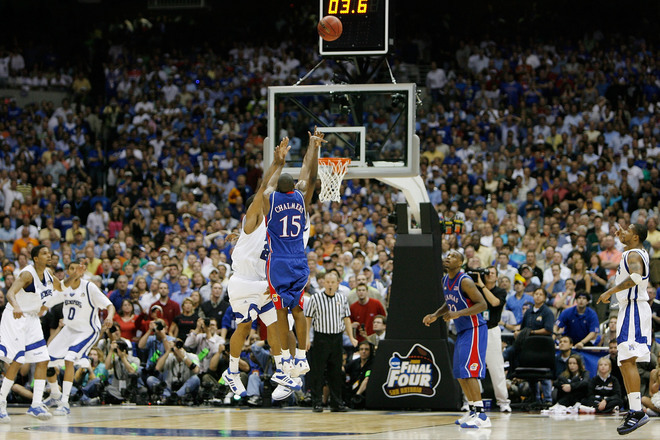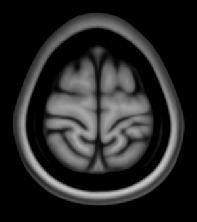Determinants of Free Decisions
I recently went over “Unconscious determinants of free decisions in the human brain” for a presentation during our weekly lab meeting. The article’s first author is Chun Siong Soon, who is an old friend from time he spent at Dartmouth several years ago. I also saw the senior author, John-Dylan Haynes, present the research at the Human Brain Mapping conference last year in Chicago. It has been interesting to see the evolution of this work, and fascinating to see the controversy surrounding it.

Using a free response task Soon et al. found that areas of frontopolar cortex and precuneus have activity that encodes which button a subject will press up to eight seconds before they actually push it (see above graph, red line). They also found that SMA and pre-SMA have activity that encodes when the subject will press a button up to five seconds before it actually happened. The most interesting timing number is that the subjects only became consciously aware of their motor intention within the last second of actually pressing the button. The logical conclusion? There was no conscious will involved – unconscious processing fully determined the outcome and timing of the button press before the conscious mind became aware of what was about to happen.
An important aspect of these results is that there was no overall increase in activity within the cortical regions. Instead, the authors used machine learning techniques to look at the spatial pattern of activity across a local ‘spotlight’ of voxels. For example, in frontopolar cortex one configuration of voxels indicated a future right button press while a slightly different configuration of activity indicated a future left button press (see above cube figure).
I tend to think of pattern recognition like listening to a symphony piece. Using our traditional approach we will only listen to one instrument at a time. We can then construct a map of what note each instrument was playing according to where they sat on stage. Using pattern recognition techniques we can begin listening to more instruments at once. We can now attend to small groups of strings or percussion to hear what the overall sound is like. This is an oversimplified view of pattern recognition, but it is appropriate.
In my view the key finding from this paper is not that the authors were able to predict the future button press with ~60% accuracy. A number of methodological factors impact the conclusions from the data – the paper says less about free will and perhaps much more about the range of cognitive operations necessary to freely press a button. Rather, I believe the key finding is that we are losing a large amount of information by limiting our search to individual voxel intensity values. By incorporating the spatial pattern of activity into our analyses we can increase the total amount of information available for hypothesis testing, which is always a desirable goal in science.
* Soon CS, Brass M, Heinze HJ, Haynes JD. (2008). Unconscious determinants of free decisions in the human brain. Nature Neuroscience,11(5):543-545.
Quote of the Week – Planck
“An experiment is a question which science poses to Nature, and a measurement is the recording of Nature’s answer.” – Max Planck
Representation of envy?
 Aldo Rustichini , Professor of Economics at the University of Minnesota, gave an interesting talk at the Sage Center yesterday titled, simply, “Envy”. He argued that envy is the social equivalent of regret and that each plays a pivotal role in decision making. He defined regret as discovering that an alternate outcome would have led to a greater benefit and defined relief as discovering an alternate outcome would have led to a greater loss. He showed data from Coricelli et al. (2005) demonstrating that areas of orbital prefrontal cortex are more active during periods of high regret compared to periods of high relief. This relationship was shown to be parametric, with activity linearly increasing as overall levels of relief decreased and regret increased [see right]. Rustichini then extended their finding by showing data that this orbital activity encodes for envy when it takes place in a social context.
Aldo Rustichini , Professor of Economics at the University of Minnesota, gave an interesting talk at the Sage Center yesterday titled, simply, “Envy”. He argued that envy is the social equivalent of regret and that each plays a pivotal role in decision making. He defined regret as discovering that an alternate outcome would have led to a greater benefit and defined relief as discovering an alternate outcome would have led to a greater loss. He showed data from Coricelli et al. (2005) demonstrating that areas of orbital prefrontal cortex are more active during periods of high regret compared to periods of high relief. This relationship was shown to be parametric, with activity linearly increasing as overall levels of relief decreased and regret increased [see right]. Rustichini then extended their finding by showing data that this orbital activity encodes for envy when it takes place in a social context.
In brief, the conditions of his study were skilled-won, skilled-lost, unskilled-won, and unskilled-lost. These indicated whether the task involved strategy and whether you did better on each trial than another human completing the tasks outside the magnet. The region in orbital cortex didn’t change its activity level at all to the unskilled conditions. However, during the skilled conditions there was an increase in signal to the skilled-won condition and a relative decrease in signal in the skilled-lost condition. He argued that this represented social envy, because its activity only changed in conditions where a competitor’s skill impacted the outcome.
The confounding factor in this argument is that it involved a test of skill. You are no longer testing just the social comparison between yourself and a competitor, but also feedback signals from orbital cortex related to skill learning. In the skilled-lost condition you need to alter your behavior to a more optimal solution whereas in the skilled-won condition you need to reinforce the strategy and skills used. Some good papers related to this processing are Furuyashiki and Gallagher (2007) and Baxter et al. (2000).
I remain unconvinced regarding the argument for envy in orbitofrontal cortex. The skilled/unskilled comparison is not the best way to approach the problem. It also highlights a question I feel we should address as we examine our results: is there a more domain-general information processing ability that might explain the data? For this study I feel that the larger umbrella of skill learning could just as easily explain the results.
Refs
– Baxter MG, Parker A, Lindner CC, Izquierdo AD, Murray EA. (2000). Control of response selection by reinforcer value requires interaction of amygdala and orbital prefrontal cortex. Journal of Neuroscience, 20(11):4311-9.
– Coricelli G, Critchley HD, Joffily M, O’Doherty JP, Sirigu A, Dolan RJ. (2005). Regret and its avoidance: a neuroimaging study of choice behavior. Nature Neuroscience, 8(9):1255-62.
– Furuyashiki T, Gallagher M. (2007). Neural encoding in the orbitofrontal cortex related to goal-directed behavior. Annals of the New York Academy of Sciences, 1121:193-215.
New Server
I knew I wouldn’t be able to host the site at Dartmouth forever. While I could leave things as they were until the end of May, I decided to be a bit proactive and move the data now. Prefrontal.org is now being run off of its own server partition at linode.com. It took a bit of education on my part to get a Linux server set up, but the new hosting solution is better in almost every way.
Back in the saddle
After wandering aimlessly through the desert raising that first cup of water to your parched lips is a simply divine experience. So too is the first blog entry after an extended hiatus.
I have been a terrible author so far in 2008. At least I have something to show for it though: a PhD. Yes friends, the thesis defense is done. I won’t even mention Sarah and I moving to California, starting a new postdoc at UCSB, and the birth of my godson Samuel. So much has gone on that it will take a few entries to catch up. It has been a long dry spell since December. Still, know that I haven’t forgotten about the blog and that new entries are on the way… ~Craig
Congratulations to the Kansas Jayhawks!

The last time the the Kansas basketball team went to the national championship was in 2003. It was my last year at Kansas and that March it was my one wish that Roy Williams would bring home the title during my senior year. Well, it didn’t work out. Not only did we lose the game but we lost our coach as well. That was hard, but five years later Bill Self and the 2008 Kansas basketball team delivered the goods in spades. Congratulations Jayhawks – you played your hearts out.
I mean, come on, that was the most clutch three-point shot I have ever seen in my life.
Dissertation: Defense Video
Have you ever sat there and thought how your life would be much more complete if you could just learn more about interoceptive development? Well my friends, worry no more. By watching this video of my dissertation defense presentation you too can know far more about this amazing topic.
Title: “The Integration of Higher Cognition and Internal State Across Development”
The video is about an hour long and runs through four of my thesis experiments. You will hear my voice on the audio track and the video track displays the slides from my Keynote presentation. I had to use the internal microphone on my MacBook, so anytime I stray away from the lectern it gets a bit quiet. Still, it worked out rather well and I am happy to present it for your viewing.
Please to enjoy…
* View online at Google Video
* Downloadable Quicktime movie [~50MB]
Dissertation: Thanks
Graduate school is a collective endeavor, requiring the participation of many if any one person is to succeed. The following is a list of people who I owe a debt of gratitude for their help along my path.
Abigail Baird: Grand Advisor
Five years ago I walked into Professor Baird’s office thinking it would be a sidenote of my interview at Dartmouth College. Instead it was the beginning of a wonderful mentorship that has taken me from being a scraggly undergraduate to a newly minted PhD. I don’t know how many meetings we have had over the years or how many subjects we have run together in the Dartmouth Brain Imaging Center, but I do know that looking back now I couldn’t imagine working with anyone else. She is one of the most amazing women I have ever known and it was my privilege to be her graduate student.
George Wolford: Dartmouth Advisor
When Abby departed for new opportunities at Vassar College I was left without an advisor at Dartmouth. George took me in and was nothing short of an amazing second mentor. His years of experience as a professor have given him a sage-like perspective on all things scientific and practical. From his statistical insight to his woodworking knowledge he was there for me during every step of my dissertation. I can’t thank him enough for all his contributions.
Daniel Ansari: Generous Colleague
When it became apparent that one of my thesis experiments would involve a magnitude detection task there was only one man to call. Dr. Ansari is a leader in the field of numerical cognition and a brilliant scientist to boot. He not only helped design the magnitude task but also provided some very welcome input on the dissertation in general. I know that things would not have gone quite as well without his guidance.
Donna Coch, Paul Whalen, Megan Steven: Committee Members
It is very hard work being a professor. Not only are there classes to teach but you also have to try and get some research done. Add to that hunting down grants so you can keep getting your research done in the future. Now, try to fit in a grad student who wants you to read a 180 page tome in your infinite spare time. Thanks to Donna, Paul, and Megan for giving of their time and energy to help me out.
Dana Peterson, Steve Michlovitz: School Administrators
You don’t just waltz into a middle school and start recruiting research participants. It takes several meetings and a LOT of paperwork before you can hope to gather data from children or adolescents. One thing that can help a great deal in this regard are teachers who have an interest in science and are willing to help. Over many years of research Steve and Dana have been unparalleled in making our research happen. My thanks to them for going above and beyond their normal duties to smooth the way.
Emily Cross, Gideon Caplovitz, Scott Gerlach, Justin Mellott: Great Friends
The doctoral thesis would be a lonely road without some goodhearted companions. Of the many people who helped out Emily, Gideon, Scott, and Justin stand out as people who really went out of their way to render assistance. They spent hours and hours as scanner buddies helping me run subjects, were sympathetic when times got tough, and, above all, knew when it was time to stop talking research and grab a pint. They are amazing people and helped keep me sane.
Sarah Bennett: My Wife
The absolute greatest part of the last five years was marrying my longtime sweetheart Sarah Johnson. My doctorate means nothing to me relative to the adventure we are taking together. She was there for every high and low as I pursued my PhD and I never, ever would have made it without her. Sarah, I owe it all to you.
Dissertation: Defended
It has been a very long road to get to this day, but after five years at Dartmouth College I have successfully defended my dissertation and completed my PhD. [whoa!]
My public talk went rather well despite the anxiety that was welling up inside. I may have stuttered a big more than average, but not terribly so. After the talk my examination committee got a private session to grill me with questions. I was expecting a focused, needling interrogation of known weaknesses in my methods and interpretation. There was some of that, but most of the discussion involved conceptual questions related to development and interoception in general. After an hour the committee excused me from the room to caucus over my fate. When they had reached a decision my advisor Abigail Baird came out into the hall and said “Congratulations, Dr. Bennett”. A very, very surreal moment in my life.
I will make another post soon with all the people I need to thank – there are many.
Now, if you will excuse me, I have some very good scotch to drink. :D
Can you see the faces?

I was knee-deep in dissertation drudgery today, making 28 tables of data for the final thesis. Not my idea of a good time. Still, you come across things that lighten your day as you work. For instance, the above axial slice was taken at z=68.5mm of the MNI 0.5mm ICBM-152 template included in FSL. As I rose up through the slices I happened upon these smiley guys. This proves two things: 1) As humans we tend to see faces in just about anything and, 2) sometimes a little smile is worth a lot when the going gets tough…
